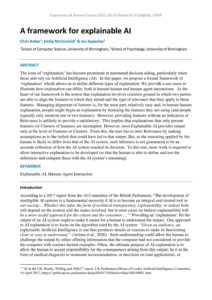| Document | Author Chris Baber, Emily McCormick & Ian Apperley |
| Abstract The issue of ‘explanation’ has become prominent in automated decision aiding, particularly when those aids rely on Artificial Intelligence (AI). In this paper, we propose a formal framework of ‘explanation’ which allows us to define different types of explanation. We provide a use-cases to illustrate how explanation can differ, both in human-human and human-agent interactions. At the heart of our framework is the notion that explanation involves common ground in which two parties are able to align the features to which they attend and the type of relevance that they apply to these features. Managing alignment of features is, for the most part, relatively easy and, in human-human explanation, people might begin an explanation by itemizing the features they are using (and people typically only mention one or two features). However, providing features without an indication of Relevance is unlikely to provide a satisfactory. This implies that explanations that only present features (or Clusters of features) are incomplete. However, most Explainable AI provides output only at the level of Features or Clusters. From this, the user has to infer Relevance by making assumptions as to the beliefs that could have led to that output. But, as the reasoning applied by the human is likely to differ from that of the AI system, such inference is not guaranteed to be an accurate reflection of how the AI system reached its decision. To this end, more work is required to allow interactive explanation to be developed (so that the human is able to define and test the inferences and compare these with the AI system’s reasoning). |

